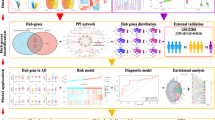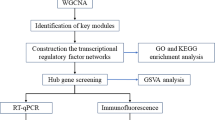Abstract
At present, there are no studies that have established a microRNA (miRNA)-based signature profile in patients with radiographic axial spondyloarthritis (rad-axial SpA), and we hypothesized that these patients may have aberrantly expressed circulating miRNAs reflective of underlying disease and inflammation. This study aims to determine the expression profile of miRNAs in plasma of patients with rad-axial SpA and compare it with healthy, age, and sex-matched controls. Fifteen subjects with rad-axial SpA based on ASAS classification criteria and 5 controls were recruited from our local SpA registry. Demographic data were collected and disease activity was measured using Bath Ankylosing Spondylitis Disease Activity Index (BASDI). Peripheral blood samples (5 ml) were obtained from eligible consenting patients and controls. RNA from the plasma was prepared using miRNeasy kit (Qiagen) by a modified protocol. Expression of 175 miRNAs was screened in the plasma of all 15 patients and 5 controls using serum/plasma miRNA PCR arrays (Exiqon Inc. Woburn, MA) essentially following the manufacturer’s instructions. Real-time PCR was carried out on StepOne Plus (Applied Biosystems) and the data was extracted and analyzed using ExiGen Enterprise software (MultiD, Göteborg, Sweden). Potential miRNA targets were identified using bioinformatics. ESR and CRP levels were measured by standard laboratory methods. We identified 7 differentially expressed miRNAs (2 upregulated and 5 downregulated). miR-34a, which was overexpressed in patients with rad-axial SpA, was predicted to target BMP-3 mRNA by TargetscanS and PicTar miRNA target algorithms. miR-150 was downregulated in all of the samples analyzed by us using the TaqMan Gene Expression assay. The most repressed miRNA was miR-16 and is predicted to regulate the expression of activin A receptor (ACVR2B), a receptor for growth, and differentiation factor-5 (GDF-5). Our data indicates that (1) patients with axial SpA, as compared to controls, have dysregulated expression of selected miRNAs in the plasma; and (2) the differentially expressed miRNAs are predicted to target genes that play a role in bone morphogenesis, growth, and immune response.

Similar content being viewed by others
References
Dougados M, Baeten D (2011) Spondyloarthritis. Lancet 377:2127–37
Dai R, Ahmed SA (2011) MicroRNA, a new paradigm for understanding immunoregulation, inflammation, and autoimmune diseases. Transl Res 157:163–79
Rudwaleit M, van der Heijde D, Landewé R, Listing J, Akkoc N, Brandt J et al (2009) The development of assessment of spondyloarthritis international society classification criteria for axial spondyloarthritis (part II): validation and final selection. Ann Rheum Dis 68:777–83
Kuhn DE, Martin MM, Feldman DS, Terry AV Jr, Nuovo GJ, Elton TS (2008) Experimental validation of miRNA targets. Methods 44:47–54
Pauley KM, Chan EK (2008) MicroRNAs and their emerging roles in immunology. Ann N Y Acad Sci 1143:226–39
Flynt AS, Lai EC (2008) Biological principles of microRNA-mediated regulation: shared themes amid diversity. Nat Rev Genet 9:831–42
Baltimore D, Boldin MP, O’Connell RM, Rao DS, Taganov KD (2008) MicroRNAs: new regulators of immune cell development and function. Nat Immunol 9:839–45
Xiao C, Srinivasan L, Calado DP, Patterson HC, Zhang B, Wang J (2008) Lymphoproliferative disease and autoimmunity in mice with increased miR-17-92 expression in lymphocytes. Nat Immunol 9:405–14
Du C et al (2009) MicroRNA miR-326 regulates TH-17 differentiation and is associated with the Pathogenesis of multiple sclerosis. Nat Immunol 10:1252–1259
Otaegui D, Baranzini SE, Armañanzas R, Calvo B, Muñoz-Culla M, Khankhanian P (2009) Differential micro RNA expression in PBMC from multiple sclerosis patients. PLoS ONE 4:e6309
Duroux-Richard I, Jorgensen C, Apparailly F (2011) What do microRNAs mean for rheumatoid arthritis? Arthritis Rheum, 26
Pauley KM, Satoh M, Chan AL, Bubb MR, Reeves WH, Chan EK et al (2008) Upregulated miR-146a expression in peripheral blood mononuclear cells from rheumatoid arthritis patients. Arthritis Res Ther 10:R101
Nakasa T, Shibuya H, Nagata Y, Niimoto T, Ochi M (2011) The inhibitory effect of microRNA-146a expression on bone destruction in collagen-induced arthritis. Arthritis Rheum 63:1582–1590
Dai Y, Huang YS, Tang M, Lv TY, Hu CX, Tan YH et al (2007) Microarray analysis of microRNA expression in peripheral blood cells of systemic lupus erythematosus patients. Lupus 16:939–946
Te JL, Dozmorov IM, Guthridge JM, Nguyen KL, Cavett JW, Kelly JA et al (2010) Identification of unique microRNA signature associated with lupus nephritis. PLoS ONE 5:e10344
Chatzikyriakidou A, Voulgari PV, Georgiou I, Drosos AA (2010) The role of microRNA-146a (miR-146a) and its target IL-1R-associated kinase (IRAK1) in psoriatic arthritis susceptibility. Scand J Immunol 71:382–5
Murata K, Yoshitomi H, Tanida S, Ishikawa M, Nishitani K, Ito H, (2010) Plasma and synovial fluid microRNAs as potential biomarkers of rheumatoid arthritis and osteoarthritis. Arthritis Res Ther 12:R86
Alevizos I, Illei GG (2010) MicroRNAs as biomarkers in rheumatic diseases. Nat Rev Rheumatol 6(7):391–8
Murata K, Furu M, Yoshitomi H, Ishikawa M, Shibuya H, Hashimoto M (2013) Comprehensive microRNA analysis identifies miR-24 and miR-125a-5p as plasma biomarkers for rheumatoid arthritis. PLoS ONE 8(7):e69118
Li J, Wan Y, Guo Q, Zou L, Zhang J, Fang Y et al (2010) Altered microRNA expression profile with miR-146a upregulation in CD4+ T cells from patients with rheumatoid arthritis. Arthritis Res Ther 12:R81
Alevizos I, Alexander S, Turner RJ, Illei GG (2011) MicroRNA expression profiles as biomarkers of minor salivary gland inflammation and dysfunction in Sjögren’s syndrome. Arthritis Rheum 63:535–44
Srivastava SK, Bhardwaj A, Singh S, Arora S, Wang B, Grizzle WE et al (2011) MicroRNA-150 directly targets MUC4 and suppresses growth and malignant behavior of pancreatic cancer cells. Carcinogenesis 32:1832–9
Nishitoh H, Ichijo H, Kimura M, Matsumoto T, Makishima F, Yamaguchi A et al (1996) Identification of type I and type II serine/threonine kinase receptors for growth/differentiation factor-5. J Biol Chem 271:21345–52
Acknowledgement
We would likely to acknowledge Dianne Morus for her role as research coordinator.
Author information
Authors and Affiliations
Corresponding author
Ethics declarations
Disclosures
None.
Rights and permissions
About this article
Cite this article
Magrey, M.N., Haqqi, T. & Haseeb, A. Identification of plasma microRNA expression profile in radiographic axial spondyloarthritis—a pilot study. Clin Rheumatol 35, 1323–1327 (2016). https://doi.org/10.1007/s10067-015-3123-7
Received:
Revised:
Accepted:
Published:
Issue Date:
DOI: https://doi.org/10.1007/s10067-015-3123-7




